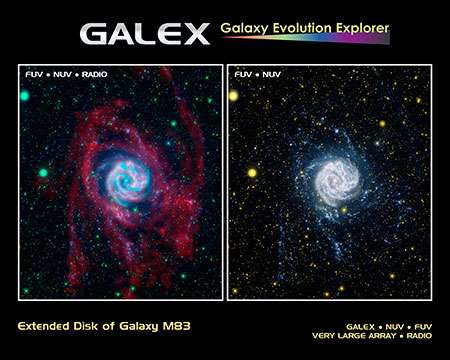Stellar extremophiles

Back in the 1970s, biologists were amazed to discover a form of life they never expected. Tiny microorganisms with ancient DNA were living in the hot springs of Yellowstone National Park. Instead of dissolving in the boiling waters, the microbes were thriving, ringing the springs with vibrant color.
Scientists coined the term extremophile, which means "extreme-loving", to describe the creatures--and the hunt was on for more. Soon, extremophiles were found living in deep Antarctic ice, the cores of nuclear reactors, and other unexpected places. Biology hasn't been the same since.
Could astronomy be on the verge of a similar transformation?
Researchers using a NASA space telescope named GALEX have discovered a new kind of extremophile: extreme-loving stars.
"We’re finding stars in extreme galactic environments where star formation isn't supposed to happen," explains GALEX project scientist Susan Neff of the Goddard Space Flight Center. “This is a very surprising development."
GALEX, which stands for “Galaxy Evolution Explorer,” is an ultraviolet space telescope with a special ability: It is super-sensitive to the kind of UV rays emitted by the youngest stars. This means the observatory can detect stars being born at very great distances from Earth, more than halfway across the Universe. The observatory was launched in 2003 on a mission to study how galaxies change and evolve as new stars coalesce inside them.
GALEX accomplished that mission—and more.
"In some GALEX images, we see stars forming outside of galaxiesin places where we thought the gas density would be too low for star birth to occur," says GALEX team member Don Neil of Caltech.
Stars are born when interstellar clouds of gas collapse and contract under the pull of their own gravity. If a cloud gets dense and hot enough as it collapses, nuclear fusion will kick in and—voila!--a star is born.
The spiral arms of the Milky Way are a "goldilocks zone" for this process. "Here in the Milky Way we have plenty of gas. It’s a cozy place for stars to form," says Neil.
But when GALEX looks at other more distant spiral galaxies, it sees stars forming far outside the gassy spiral disk.
"I was dumbfounded," he says. "These stars are truly 'living on the edge. '"
Spirals aren’t the only galaxies with stellar extremophiles. The observatory has also found stars being born
--in elliptical and irregular galaxies thought to be gas-poor (e.g., 1, 2)
--in the gaseous debris of colliding galaxies (1, 2)
--in vast "comet-like" tails that trail behind some fast-moving galaxies (1, 2)
--in cold primordial gas clouds, which are small and barely massive enough to hang together
So much for the Goldilocks Zone. According to GALEX, stellar extremophiles populate just about every nook and cranny of the cosmos where a wisp of gas can get together to make a new sun.
“This could be telling us something profound about the star-forming process,” says Neff. “There could be ways to make stars in extreme environments that we haven’t even thought of yet.”
Will extremophiles transform astronomy as they did biology? It’s too soon to say, insist the researchers. But GALEX has definitely given them something to think about.
Provided by Science@NASA



















